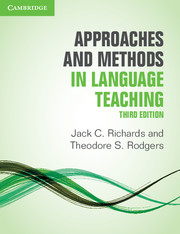Book contents
- Frontmatter
- Contents
- Acknowledgments
- Introduction to the third edition
- I Major trends in twentieth-century language teaching
- II Current approaches and methods
- III Alternative twentieth-century approaches and methods
- IV The teaching and learning environment
- Appendix: Comparison of approaches and methods
- Author index
- Subject index
14 - The Natural Approach
Published online by Cambridge University Press: 08 April 2022
- Frontmatter
- Contents
- Acknowledgments
- Introduction to the third edition
- I Major trends in twentieth-century language teaching
- II Current approaches and methods
- III Alternative twentieth-century approaches and methods
- IV The teaching and learning environment
- Appendix: Comparison of approaches and methods
- Author index
- Subject index
Summary
Introduction
In 1977, Tracy Terrell, a teacher of Spanish in California, outlined “a proposal for a ‘new’ philosophy of language teaching which [he] called the Natural Approach” (1977; 1982: 121). This was an attempt to develop a language teaching proposal that incorporated the “natu-ralistic” principles researchers had identified in studies of second language acquisition. In the Natural Approach there is an emphasis on exposure, or input, rather than practice; optimizing emotional preparedness for learning; a prolonged period of attention to what the language learners hear before they try to produce language; and a willingness to use written and other materials as a source of input.
The Natural Approach grew out of Terrell's experiences of teaching Spanish classes, although it has also been used in elementary to advanced-level classes and with several other languages. At the same time, he joined forces with Stephen Krashen, an applied lin-guist at the University of Southern California, in elaborating a theoretical rationale for the Natural Approach, drawing on Krashen's understanding of the findings of the emerging field of second language acquisition. Krashen and Terrell's combined statement of the prin-ciples and practices of the Natural Approach appeared in their book The Natural Approach, published in 1983. At the time the Natural Approach attracted a wide interest because of the accessibility of the principles on which it was based, the ease with which it confirmed many teachers’ common sense understandings of second language learning, the fact it appeared to be supported by state-of-the-art theory and research, and the fact that Krashen himself is a charismatic presenter and persuasive advocate of his own views – as is evident from the numerous examples of his presentations available on the Internet. Krashen and Terrell's book contains theoretical sections prepared by Krashen that outline his views on second language acquisition (Krashen 1981, 1982), and sections on implementation and classroom procedures, prepared largely by Terrell.
Krashen and Terrell identified the Natural Approach with what they call “traditional” approaches to language teaching. Traditional approaches are defined as “based on the use of language in communicative situations without recourse to the native language” – and, per-haps, needless to say, without reference to grammatical analysis, grammatical drilling, or a particular theory of grammar.
Information
- Type
- Chapter
- Information
- Approaches and Methods in Language Teaching , pp. 261 - 276Publisher: Cambridge University PressPrint publication year: 2014
